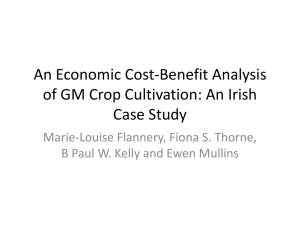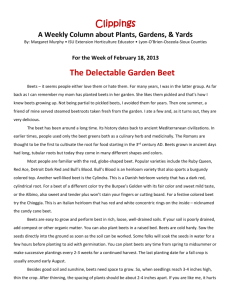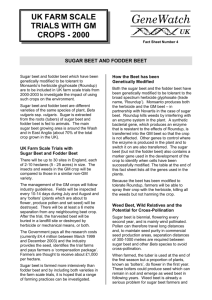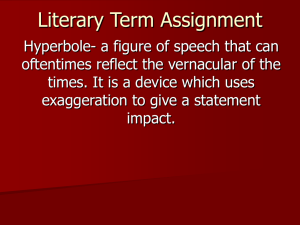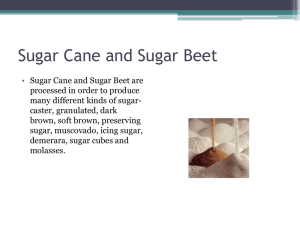Presentation File - 2012 US Biochar Conference
advertisement
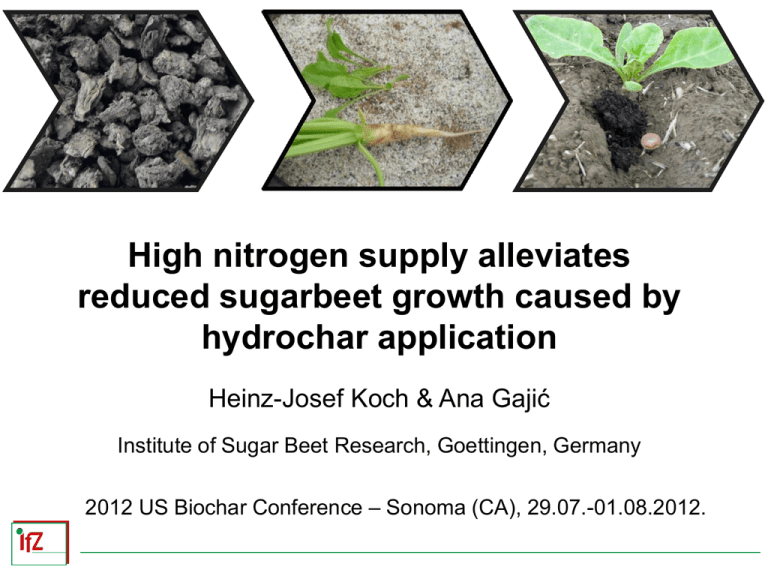
High nitrogen supply alleviates reduced sugarbeet growth caused by hydrochar application Heinz-Josef Koch & Ana Gajić Institute of Sugar Beet Research, Goettingen, Germany 2012 US Biochar Conference – Sonoma (CA), 29.07.-01.08.2012. Introduction | Material and Methods | Results and Discussion | Summary and Outlook 2 In Germany, increasing cultivation of energy crops and use of crop residues for energy production has considerably reduced the amount of crop residue left on arable fields The German Federal Soil Protection Act stipulates that "the site-specific soil humus content must be preserved by the agricultural practices applied, in particular by an adequate supply of organic matter ...“ To prevent humus depletion of arable fields, alternative practices and concepts must be developed (e.g. biochar, hydrochar) Introduction | Material and Methods | Results and Discussion | Summary and Outlook 3 F. Bergius (1913) – HydroThermal Carbonization Biomass → hydrochar + process water + gas + heat Processing conditions: aqueous solution (acidic), 180 - 250 °C, 4 - 12 h Carbon conversion efficiency ~ 90% Hydrochar (HTC-biochar) Lignite alike product Energy production HTC Hydrochar nanoparticles Large specific surface area Nutrient storage and buffering? Porous structure Water storage? Decomposition stability Carbon sequestration? Introduction | Material and Methods | Results and Discussion | Summary and Outlook 4 Hydrochar production conditions: 12 h, 190 °C Plant available nutrients Hydrochar N made from NO3, NH4 P CAL K CAL Mg CaCl2 [g kg-1] -------- Other properties ----Ct Nt C:N pH EC [%] [%] [] [] [mS cm-1] Beet pulp 0.3 0.5 0.4 0.2 50.1 1.3 38.3 5.9 2.8 Draff** 0.4 1.0 0.3 0.5 54.4 3.5 15.5 5.3 2.3 * VDLUFA - horticultural substrates **Spent grains The aim of this study was to investigate the effect of hydrochar on sugar beet growth and mineral N (Nmin) availability on typical German arable soils. Introduction | Material and Methods | Results and Discussion | Summary and Outlook 5 Field trial (51 N, 10 E) Luvisol (loessial), temperate climate (620 mm, ~9 °C) 2 factorial (split-plot, 4 replicates) 1. Hydrochar (H) Control, Beet pulp, Draff 2. Nitrogen fertilization (N) 0, 50, 100, 150 kg N ha-1 Hydrochar 10 Mg ha-1 (dm) Test crop: Sugar beet (April – October) Site Goettingen, 2010 Introduction | Material and Methods | Results and Discussion | Summary and Outlook 6 May: Hydrochar effect on seedling emergence and growth H ns | N ns | HxN ns DC 10 DC 12 DC 14 Growth stage: DC 14 4-6 leaves 80 60 DC 12 2-4 leaves 40 20 DC 10 cotyledon Control Beet pulp 50 10 0 0 50 10 0 0 -1 kg N ha : 50 10 0 0 0 Seedling emergence [%] 100 Draff ----------Hydrochar---------- Beet pulp / N0 Introduction | Material and Methods | Results and Discussion | Summary and Outlook 7 June harvest: Hydrochar effect on sugar beet yield and N content Yield H ** | N ** | HxN ** N content H ns | N ** | HxN ns 10 d 800 8 cd 600 bc b 400 bc bc b 6 a 200 4 Control Beet pulp 0 50 10 0 0 0 50 10 0 0 -1 kg N ha : Draff ----------Hydrochar---------- N content [% in dm] d 0 50 10 0 Single plant yield [mg, dm] 1000 Introduction | Material and Methods | Results and Discussion | Summary and Outlook 8 Hydrochar effect on Soil Nmin (N-NO3 + N-NH4) and 4 150 b 100 a a 50 -2 200 3 2 Control Beet pulp Draff Nmin 0-30 cm Leaf Area Index [m m ] -1 Nmin 0-90 cm [kg N ha ] 250 0 Sampling: 05. May ns Leaf Area Index 2 1 Control Beet pulp Draff 0 09. Jun ns 07. Jul *** 30. Sep ns . 28 n Ju l 12 u .J 26 u .J l g 09 u .A g 24 u .A 06 e .S p Introduction | Material and Methods | Results and Discussion | Summary and Outlook 9 October harvest: Hydrochar effect on Beet N Uptake and White Sugar Yield 13 H ** | N ** | HxN ns H ** | N ns | HxN ** 50 0-1 kg N ha : B A B 0 50 00 50 1 1 Control 0 50 00 50 1 1 Beet pulp 0 50 00 50 1 1 Draff --------Hydrochar-------- 11 c c c c b b b 10 0 kg N ha-1 Control c c b b b a a Beet pulp c c c c b b b b a a 0 50 10 150 0 75 12 0 50 10 150 0 100 0 50 10 150 0 -1 Beet N uptake [kg ha ] -1 Adjusted sugar yield [Mg ha ] 125 Draff -------Hydrochar-------- Introduction | Material and Methods | Results and Discussion | Summary and Outlook 10 Greenhouse trial Cambisol (100 mg N kg-1), 1 kg soil pot-1 Block design (4 replicates) 1. Hydrochar (H) Control, Beet pulp, Draff 2. Nitrogen fertilization (N) 0, 100, 200 mg N kg-1 soil Hydrochar 30 Mg ha-1 (dm) Test crop: Sugar beet 4 weeks of growing, 20 °C, 40-80 % WHCmax IfZ Goettingen, 2011 Introduction | Material and Methods | Results and Discussion | Summary and Outlook 11 Hydrochar effect on single plant yield and N content Control Whole plants harvested after 4 weeks of growing Yield: H ** | N ** | HxN ** N content: H ** | N ** | HxN * e 800 10 e e e de 600 400 200 6 cd c e e d c ab 0 0 0 -1 0 mg N kg : 10 20 Control 8 b a b c b 2 Beet Beetpulp pulp Draff Beer draff a 0 00 00 1 2 Beet pulp 4 N content [% in dm] Single plant yield [mg, dm] 1000 0 00 00 1 2 Draff --------Hydrochar-------- 0 Introduction | Material and Methods | Results and Discussion | Summary and Outlook 12 Hydrochar effects (10-30 Mg ha-1) on Early sugar beet growth: Seedling emergence and establishment was not affected Seedling growth was significantly reduced at low N supply Increased N supply partly (field) or completely (greenhouse) compensated for stunted early growth (toxic compounds?) Early growth reduction was more severe with hydrochar from beet pulp (C/N 38) compared to draff (C/N 16) N immobilization Final sugar beet yield and quality: No yield decrease due to hydrochar, when N supply was adequate Beet pulp hydrochar (but not draff) reduced yield at low N supply Draff hydrochar slightly increased N uptake at low N supply → Re-mineralization of N Introduction | Material and Methods | Results and Discussion | Summary and Outlook 13 Mean residence time (microcosm study): Wheat straw (1 y) < Hydrochar (5-8 y) <<< Biochar (4x1012 y) Hydrochar (30 Mg ha-1) effects on soil properties: pH and CEC Aggregate stability Water holding capacity Open questions Optimum HTC conditions: feedstock, temperature, time? Optimum crop and time of application? Phytotoxicity? C balance, energy balance, GHG emission? Thanks for Your attention! 14 Gajić, A. & Koch H.-J. (2012): Sugar Beet (Beta vulgaris L.) Growth Reduction Caused by Hydrochar Is Related to Nitrogen Supply. J Environ Qual doi:10.2134/jeq2011.0237.

